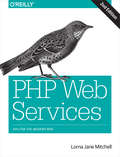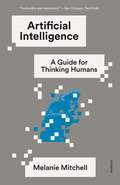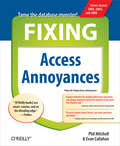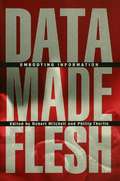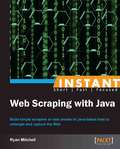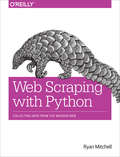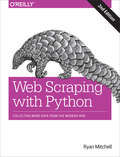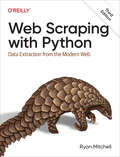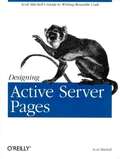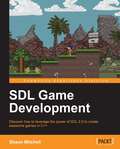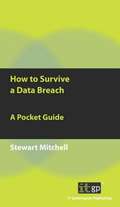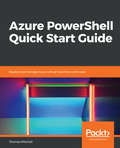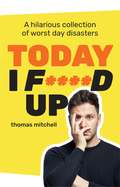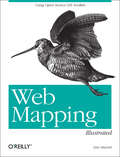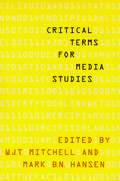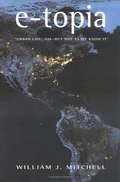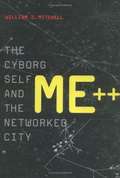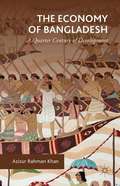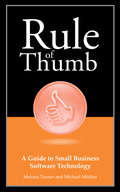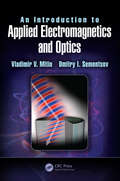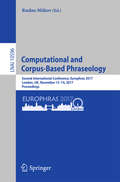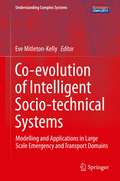- Table View
- List View
PHP Web Services
by Lorna Jane MitchellWhether you're sharing data between two internal systems or building an API so users can access their data, this practical book provides everything you need to build web service APIs with PHP. Author Lorna Jane Mitchell uses code samples, real-world examples, and advice based on her extensive experience to guide you through the process--from the underlying theory to methods for making your service robust. PHP is ideally suited for both consuming and creating web services. You'll learn how to use this language with JSON, XML, and other web service technologies. Explore HTTP, from the request/response cycle to its verbs, headers, and cookies Determine whether JSON or XML is the best data format for your application Get practical advice for working with RPC, SOAP, and RESTful services Use a variety of tools and techniques for debugging HTTP web services Choose the service that works best for your application, and learn how to make it robust Learn how to document your API--and how to design it to handle errors
Artificial Intelligence: A Guide for Thinking Humans (Pelican Bks.)
by Melanie MitchellNo recent scientific enterprise has proved as alluring, terrifying, and filled with extravagant promise and frustrating setbacks as artificial intelligence. The award-winning author Melanie Mitchell, a leading computer scientist, now reveals AI’s turbulent history and the recent spate of apparent successes, grand hopes, and emerging fears surrounding it.In Artificial Intelligence, Mitchell turns to the most urgent questions concerning AI today: How intelligent—really—are the best AI programs? How do they work? What can they actually do, and when do they fail? How humanlike do we expect them to become, and how soon do we need to worry about them surpassing us? Along the way, she introduces the dominant models of modern AI and machine learning, describing cutting-edge AI programs, their human inventors, and the historical lines of thought underpinning recent achievements. She meets with fellow experts such as Douglas Hofstadter, the cognitive scientist and Pulitzer Prize–winning author of the modern classic Gödel, Escher, Bach, who explains why he is “terrified” about the future of AI. She explores the profound disconnect between the hype and the actual achievements in AI, providing a clear sense of what the field has accomplished and how much further it has to go. Interweaving stories about the science of AI and the people behind it, Artificial Intelligence brims with clear-sighted, captivating, and accessible accounts of the most interesting and provocative modern work in the field, flavored with Mitchell’s humor and personal observations. This frank, lively book is an indispensable guide to understanding today’s AI, its quest for “human-level” intelligence, and its impact on the future for us all.
Fixing Access Annoyances: How to Fix the Most Annoying Things About Your Favorite Database (Annoyances)
by Phil Mitchell Evan CallahanWhen an application is part of the Microsoft Office suite, it's sure to be a leader in its field. In the realm of desktop database management, Access is top dog with millions of users. But this is one dog that can bite. Although Access is a powerful, relational tool with the fetching talents of a Labrador, it's not an easy beast to train. Still, millions of users count on Access for everything from managing parts databases to running Web catalogs to working as a front end to mondo SQL databases. But Access is chockablock with annoyances---report hassles, query conundrums, VBA bugs, arcane error messages, and more. O'Reilly's Annoyances series offer real-world help, right now, and Fixing Access Annoyances continues tradition. You'll not only squash bugs and workaround Access' limits, but you'll learn how to use Access to the max, whether you're a newbie or a seasoned pro. Coverage includes install/configuration annoyances, building better tables and queries, creating forms that work right, generating reliable and sophisticated reports, pulling in data from a variety of sources, crafting macros and VBA code to customize Access, and much more. You could grab those other books for help, but do they solve problems from page one? Meet a book of a different stripe. The authors come armed with knowledge of the program's quirks, design hurdles and interface snags. They provide you with battle plans in Fixing Access Annoyances to save you time and bouts of hair pulling. Stop information from spiraling out of control when working with Access and trying to make this #$@@#$ thing work! Don't let its quirks, bugs, and troublemaking features beat you. Who you gonna call for help? Instead of waiting on the line for tech support or searching for the answer on the Internet with its too many resources to find exactly what you need, take control of databases with Fixing Access Annoyances , your partner on database adventures.
Data Made Flesh: Embodying Information
by Robert Mitchell Phillip ThurtleIn an age of cloning, cyborgs, and biotechnology, the line between bodies and bytes seems to be disappearing. Data Made Flesh is the first collection to address the increasingly important links between information and embodiment, at a moment when we are routinely tempted, in the words of Donna Haraway, "to be raptured out of the bodies that matter in the lust for information," whether in the rush to complete the Human Genome Project or in the race to clone a human being.
Instant Web Scraping with Java
by Ryan MitchellThis book is full of short, concise recipes to learn a variety of useful web scraping techniques using Java. You will start with a simple basic recipe of setting up your Java environment and gradually learn some more advanced recipes such as using complex Scrapers.Instant Web Scraping with Java is aimed at developers who, while not necessarily familiar with Java, are at least ready to dive into the complexities of this language with simple, step-by-step instructions leading the way. It is assumed that you have at least an intermediate knowledge of HTML, some knowledge of MySQL, and access to an Internet-connected computer while doing most of the exercises (after all, scraping the Web is difficult if your code can't get online!)
Web Scraping with Python
by Ryan MitchellLearn web scraping and crawling techniques to access unlimited data from any web source in any format. With this practical guide, you'll learn how to use Python scripts and web APIs to gather and process data from thousands--or even millions--of web pages at once.Ideal for programmers, security professionals, and web administrators familiar with Python, this book not only teaches basic web scraping mechanics, but also delves into more advanced topics, such as analyzing raw data or using scrapers for frontend website testing. Code samples are available to help you understand the concepts in practice.Learn how to parse complicated HTML pagesTraverse multiple pages and sitesGet a general overview of APIs and how they workLearn several methods for storing the data you scrapeDownload, read, and extract data from documentsUse tools and techniques to clean badly formatted dataRead and write natural languagesCrawl through forms and loginsUnderstand how to scrape JavaScriptLearn image processing and text recognition
Web Scraping with Python: Collecting More Data from the Modern Web
by Ryan MitchellIf programming is magic then web scraping is surely a form of wizardry. By writing a simple automated program, you can query web servers, request data, and parse it to extract the information you need. The expanded edition of this practical book not only introduces you web scraping, but also serves as a comprehensive guide to scraping almost every type of data from the modern web.Part I focuses on web scraping mechanics: using Python to request information from a web server, performing basic handling of the server’s response, and interacting with sites in an automated fashion. Part II explores a variety of more specific tools and applications to fit any web scraping scenario you’re likely to encounter.Parse complicated HTML pagesDevelop crawlers with the Scrapy frameworkLearn methods to store data you scrapeRead and extract data from documentsClean and normalize badly formatted dataRead and write natural languagesCrawl through forms and loginsScrape JavaScript and crawl through APIsUse and write image-to-text softwareAvoid scraping traps and bot blockersUse scrapers to test your website
Web Scraping with Python: Collecting More Data From The Modern Web
by Ryan MitchellIf programming is magic, then web scraping is surely a form of wizardry. By writing a simple automated program, you can query web servers, request data, and parse it to extract the information you need. This thoroughly updated third edition not only introduces you to web scraping but also serves as a comprehensive guide to scraping almost every type of data from the modern web.Part I focuses on web scraping mechanics: using Python to request information from a web server, performing basic handling of the server's response, and interacting with sites in an automated fashion. Part II explores a variety of more specific tools and applications to fit any web scraping scenario you're likely to encounter.Parse complicated HTML pagesDevelop crawlers with the Scrapy frameworkLearn methods to store the data you scrapeRead and extract data from documentsClean and normalize badly formatted dataRead and write natural languagesCrawl through forms and loginsScrape JavaScript and crawl through APIsUse and write image-to-text softwareAvoid scraping traps and bot blockersUse scrapers to test your website
Designing Active Server Pages
by Scott MitchellDesigning Active Server Pagesis written for those who have already mastered the basics of ASP application development and are ready to move to the next level--such as creating reusable ASP pages that can save a great deal of development time. And unlike other books on ASP, Designing Active Server Pagesshows you how to use other scripting languages that ASP supports in addition to VBScript.
Designing Active Server Pages
by Scott MitchellDevelopers of Active Server Pages often reinvent the wheel. Their background in web design, with its separate HTML page for each viewable web page on a site, leads many ASP developers to create a distinct ASP page each time they think they need one. Often times, these pages are functionally similar. With intelligent planning, an ASP developer stands to save a great deal of time by creating reusable ASP pages. Designing Active Server Pages is tailor-made for these developers. There is currently a plethora of Active Server Pages books. However, the vast majority of these books are either technical references or how-to books for beginners. Designing Active Server Pages is written for the intermediate to advanced user. Furthermore, nearly every other book on ASP focuses on using VBScript, even though ASP supports an array of scripting languages, including JScript and PerlScript. Designing Active Server Pages shows how to start using these other languages. The latest version of the scripting engines (Version 5.1 for VBScript) adds new features not available before the 5.0 release. These features include class support for VBScript, and Regular Expression searching through the use of a COM object. Designing Active Server Pages explains why using classes in VBScript is beneficial, and demonstrates the power of regular expression searching. This book shows how to simplify the process by only requiring one ASP page to handle ALL of the Forms throughout a web site, thus reducing the amount of code one has to write. Topics include: Using various Microsoft and third-party components to enhance ASP pages Creating components using VB and/or VC++ Sample code for performing routine ASP tasks Techniques to allow for reusable database scripts on the database system and on ASP pages How to obtain and register third-party components, thus saving massive amounts of time by reusing someone else's code Designing Active Server Pages is for developers who have already mastered the basics of ASP application development and are ready to take the next logical step. It is sure to become an indispensable part of every web developer's library.
SDL Game Development
by Shaun MitchellWritten as a practical and engaging tutorial, SDL Game Development guides you through developing your own framework and the creation of two engaging games.If you know C++ and you're looking to make great games from the ground up, then this book is perfect for you.
How to Survive a Data Breach: A Pocket Guide
by Stewart MitchellData breaches are, for most organizations, a crushing blow to their customers' and staff's confidence in them, to their reputation and brand value, and to the career prospects of senior executives. A data breach may be an even bigger calamity to the individuals whose data has been exposed to Internet criminals, to the press and, possibly, to malicious and ill-wishing acquaintances. Identity theft is a growing problem, and one which is inadequately policed. Individuals whose personal and/or financial data has been breached can find that their credit histories are compromised, and may have to spend years and substantial sums clearing their names. Those organizations that have a tried and tested procedure in place for dealing with data breaches will not only put themselves in a position to obey the current and emerging data breach legislation but, more importantly, will enable themselves to win back some respect from the customers whose data has been breached. This pocket guide provides essential support for organizations tackling this mission. The information is drawn from various regulatory publications, and interviews with security experts, lawyers and software suppliers.
Managing Information Risk: A Director's Guide
by Stewart MitchellThis pocket guide addresses the scope of risks involved in a modern IT system, and outlines strategies for working through the process of putting risk management at the heart of your corporate culture. This pocket guide should provide decision makers with a solid overview of the factors they need to consider and a framework for implementing a regime that suits their needs. It provides a checklist of steps that companies need to take to safeguard against various threats, highlights potential vulnerabilities and lists methodologies for mitigating against the risks. This pocket guide draws on previous works by senior security advisory bodies - in particular the US National Institute of Standards and Technology, which has produced numerous landmark 'Special Publications' on the subject, and various UK government guidelines drawn up in the wake of high- profile data breaches. UK governmental and industry white papers were also consulted during research, including interviews with security analysts and board-level risk management practitioners.
Azure PowerShell Quick Start Guide: Deploy and manage Azure virtual machines with ease
by Thomas MitchellLeverage PowerShell to perform many day-to-day tasks in Microsoft Azure Key Features Deploy and manage Azure virtual machines with PowerShell commands. Get to grips with core concept of Azure PowerShell such as working with images and disks, custom script extension, high availability and more. Leverage hands-on projects to successfully apply what you learned through the course of this book. Book Description As an IT professional, it is important to keep up with cloud technologies and learn to manage those technologies. PowerShell is a critical tool that must be learned in order to effectively and more easily manage many Azure resources. This book is designed to teach you to leverage PowerShell to enable you to perform many day-to-day tasks in Microsoft Azure. Taking you through the basic tasks of installing Azure PowerShell and connecting to Azure, you will learn to properly connect to an Azure tenant with PowerShell. Next, you will dive into tasks such as deploying virtual machines with PowerShell, resizing them, and managing their power states with PowerShell. Then, you will learn how to complete more complex Azure tasks with PowerShell, such as deploying virtual machines from custom images, creating images from existing virtual machines, and creating and managing of data disks. Later, you will learn how to snapshot virtual machines, how to encrypt virtual machines, and how to leverage load balancers to ensure high availability with PowerShell. By the end of this book, you will have developed dozens of PowerShell skills that are invaluable in the deployment and management of Azure virtual machines. What you will learn Manage virtual machines with PowerShell Resize a virtual machine with PowerShell Create OS disk snapshots via PowerShell Deploy new virtual machines from snapshots via PowerShell Provision and attach data disks to a virtual machine via PowerShell Load balance virtual machines with PowerShell Manage virtual machines with custom script extensions Who this book is for This book is intended for IT professionals who are responsible for managing Azure virtual machines. No prior PowerShell or Azure experience is needed.
Today I F****d Up
by Thomas MitchellA toe curling, laugh out loud collection of worst day disasters. I&’d always rolled my eyes when people describe things as 'happening in slow motion'. Surely everything happens in regular time and it's only when you replay it in your head that it seems to slow down?But as the car lurched forward and I found myself sailing through the back of the garage, I finally understood what they meant. When a trip to meet his new girlfriend&’s grandparents ends in disaster (think a crashed ute, an angry wasp and a cranky farmer with a shotgun), Thomas Mitchell knows one thing for sure: bad days make for great stories. While we might not like to admit it, we can't help but find a sneaky pleasure in other people's misfortune. It's the reason fail compilations rack up millions of views on YouTube or television shows like Funniest Home Videos exist at all. Deep down we're addicted to the downfall of our fellow humans, and if there was ever a point in history when we needed a laugh, it's now. Today I F***D Up is a collection of tall tales but true that are equal parts hilarious and horrifying; a timely reminder that no matter how terrible things get, they could always be worse. So much worse.
Web Mapping Illustrated
by Tyler MitchellWith the help of the Internet and accompanying tools, creating and publishing online maps has become easier and rich with options. A city guide web site can use maps to show the location of restaurants, museums, and art venues. A business can post a map for reaching its offices. The state government can present a map showing average income by area. Developers who want to publish maps on the web often discover that commercial tools cost too much and hunting down the free tools scattered across Internet can use up too much of your time and resources. Web Mapping Illustrated shows you how to create maps, even interactive maps, with free tools, including MapServer, OpenEV, GDAL/OGR, and PostGIS. It also explains how to find, collect, understand, use, and share mapping data, both over the traditional Web and using OGC-standard services like WFS and WMS. Mapping is a growing field that goes beyond collecting and analyzing GIS data. Web Mapping Illustrated shows how to combine free geographic data, GPS, and data management tools into one resource for your mapping information needs so you don't have to lose your way while searching for it. Remember the fun you had exploring the world with maps? Experience the fun again with Web Mapping Illustrated. This book will take you on a direct route to creating valuable maps.
Critical Terms for Media Studies
by W. J. T. Mitchell Mark HansenCommunications, philosophy, film and video, digital culture: media studies straddles an astounding array of fields and disciplines and produces a vocabulary that is in equal parts rigorous and intuitive. Critical Terms for Media Studiesdefines, and at times, redefines, what this new and hybrid area aims to do, illuminating the key concepts behind its liveliest debates and most dynamic topics. Part of a larger conversation that engages culture, technology, and politics, this exciting collection of essays explores our most critical language for dealing with the qualities and modes of contemporary media. Edited by two outstanding scholars in the field, W.J.T. Mitchell and Mark B.N. Hansen, the volume features works by a team of distinguished contributors.
E-topia: Urban Life, Jim--But Not As We Know It
by William J. MitchellThe global digital network is not just a delivery system for email, Web pages, and digital television. It is a whole new urban infrastructure--one that will change the forms of our cities as dramatically as railroads, highways, electric power supply, and telephone networks did in the past. Picking up where his best-selling City of Bits left off, Mitchell argues that we must extend the definitions of architecture and urban design to encompass virtual places as well as physical ones, and interconnection by means of telecommunication links as well as by pedestrian circulation and mechanized transportation systems. He proposes strategies for the creation of cities that not only will be sustainable but will make economic, social, and cultural sense in an electronically interconnected and global world. The new settlement patterns of the twenty-first century will be characterized by live/work dwellings, 24-hour pedestrian-scale neighborhoods rich in social relationships, and vigorous local community life, complemented by far-flung configurations of electronic meeting places and decentralized production, marketing, and distribution systems. Neither digiphile nor digiphobe, Mitchell advocates the creation of e-topias--cities that work smarter, not harder.
Me++: The Cyborg Self and the Networked City
by William J. MitchellWilliam Mitchell describes the transformation of wireless technology in the hundred years since Marconi; the scaling up of networks and the scaling down of the apparatus for transmission and reception.
Materiality, Rules and Regulation: New Trends in Management and Organization Studies (Technology, Work and Globalization)
by Nathalie Mitev François-Xavier de Vaujany Anouk Mukherjee Giovan LanzaraMateriality, Rules and Regulation: New Trend in Management and Organization Studies concentrates on the relationship of rules and regulation to the materiality of artefacts, practices, and organizations. It combines the recent scholarly interest on sociomateriality with a focus on regulation and rules.
Rule of Thumb: A Small Business Guide To Software Technology (Rule of Thumb #9)
by Michael Mitilier Melissa TurnerBecoming the leader of a successful company requires not only good business sense, but also the knowledge to effectively use a multitude of software technologies to communicate effectively with clients. However, when it comes to putting business software to good use, many individuals find themselves navigating the vast expanse of technology alone, wasting valuable time and money through trial and error. "Rule of Thumb: A Guide to Small Business Software Technology" provides useful tips and guidelines to get you on the fast-track to creating professional-looking documents with the Microsoft Office Suite and PDF technology. This easy to follow book includes step-by-step instructions and time-saving shortcuts. it's a must-have reference guide for all small business owners and those looking to improve their knowledge of these essential business tools.
An Introduction to Applied Electromagnetics and Optics
by Vladimir V. Mitin Dmitry I. SementsovModern technology is rapidly developing and for this reason future engineers need to acquire advanced knowledge in science and technology, including electromagnetic phenomena. This book is a contemporary text of a one-semester course for junior electrical engineering students. It covers a broad spectrum of electromagnetic phenomena such as, surface waves, plasmas, photonic crystals, negative refraction as well as related materials including superconductors. In addition, the text brings together electromagnetism and optics as the majority of texts discuss electromagnetism disconnected from optics. In contrast, in this book both are discussed. Seven labs have been developed to accompany the material of the book.
Computational and Corpus-Based Phraseology: Second International Conference, Europhras 2017, London, UK, November 13-14, 2017, Proceedings (Lecture Notes in Computer Science #10596)
by Ruslan MitkovThis book constitutes the refereed proceedings of the International Conference on Computational and Corpus-Based Phraseology, Europhras 2017, held in London, UK, in November 2017. The 31 full papers presented were carefully reviewed and selected from numerous submissions and are organized into the following thematic sessions: Phraseology in translation and contrastive studies, Lexicography and terminography, Exploitation of corpora in phraseological studies, Development of corpora for phraseological studies, Phraseology and language learning, Cognitive and cultural aspects of phraseology, Theoretical and descriptive approaches to phraseology, and Computational approaches to phraseology. The chapter 'Frequency Consolidation Among Word N-Grams' is available open access under a CC BY 4. 0 license.
Mathematical Structures of Ergodicity and Chaos in Population Dynamics (Studies in Systems, Decision and Control #312)
by Paweł J. MitkowskiThis book concerns issues related to biomathematics, medicine, or cybernetics as practiced by engineers. Considered population dynamics models are still in the interest of researchers, and even this interest is increasing, especially now in the time of SARS-CoV-2 coronavirus pandemic, when models are intensively studied in order to help predict its behaviour within human population. The structures of population dynamics models and practical methods of finding their solutions are discussed. Finally, the hypothesis of the existence of non-trivial ergodic properties of the model of erythropoietic response dynamics formulated by A. Lasota in the form of delay differential equation with unimodal feedback is analysed. The research can be compared with actual medical data, as well as shows that the structures of population models can reflect the dynamic structures of reality.
Co-evolution of Intelligent Socio-technical Systems: Modelling and Applications in Large Scale Emergency and Transport Domains (Understanding Complex Systems)
by Evangelia Mitleton-KellyAs the interconnectivity between humans through technical devices is becoming ubiquitous, the next step is already in the making: ambient intelligence, i.e. smart (technical) environments, which will eventually play the same active role in communication as the human players, leading to a co-evolution in all domains where real-time communication is essential. This topical volume, based on the findings of the Socionical European research project, gives equal attention to two highly relevant domains of applications: transport, specifically traffic, dynamics from the viewpoint of a socio-technical interaction and evacuation scenarios for large-scale emergency situations. Care was taken to investigate as much as possible the limits of scalability and to combine the modeling using complex systems science approaches with relevant data analysis.
